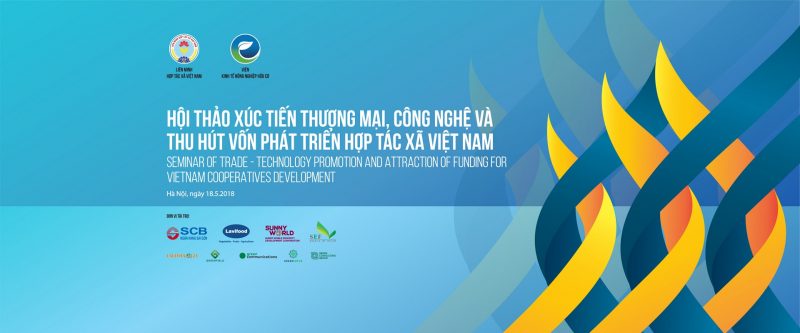
Deputy Prime Minister Vuong Dinh Hue applauded efforts to develop agriculture and support agricultural cooperatives in Vietnam – Taken by TTXVN
Cooperative economy is a long-lasting business and has many advantages. The issue here is how to maximize resources for cooperative development in current economic and social situation.
Speaking at the Seminar of Trade – Technology Promotion and Attraction of Funding for Vietnam Cooperatives Development in Hanoi on May 18th, Mr. Le Thanh, Director of Institute of Organic Agricultural Economics, co-organizer, suggested that cooperative model is never outdated. That is also Mr.Balu Iyer’s opinion, General Director of Asia-Pacific International Cooperative Alliance…

A number of solutions to remove difficulties and to make use of resources of the cooperatives were presented at the conference
Born in 1948, cooperative model is one of the long-lasting business models in Vietnam. To date, Vietnam has had a total of over 20,200 cooperatives, 93,220 cooperative groups and 59 cooperative unions, contributing significantly to the overall development of the economy. This model was born in the late nineteenth century in the world. A cooperative is a collective economic organization, co-owned by at least 7 members. The link between the members creates the strength of the cooperative.
Mr. Nguyen Ngoc Bao, President of Vietnam Cooperative Alliance, said that through mutual association, cooperation and assistance, cooperative members can help each other out of poverty by creating economic opportunities, creating jobs, increasing income, training work skills, improving capacity, economic and social status. Unlike conventional businesses, co-operative members are concurrently owners of co-operatives and receive surplus profits from cooperatives on the basis of the level of service utilization and economic activities implemented with cooperatives. No one is left behind in the process of development, and the movement of society is a humanitarian goal cooperatives hope to achieved.

When farmers join together, cooperative economy brings collective strength to them
In Vietnam, farmers are vulnerable. Change in price of agricultural products strongly influences on their life and income. The calls for rescuing agricultural products, when agricultural products are in bumpers but at low price reveal many limitations, especially in terms of their sustainability.
Lavifood, one of the leading companies in the field of processing – exporting fruits, vegetables and agricultural products, has sought an effective way for Vietnamese agricultural products by collaborating with ILMI Group of Korea to build Agro-processing factories, especially radishes which, not long ago, were rescued successfully. It is expected that in mid-2019, when the factory goes into operation, it will process thousands of tons of radishes and vegetables every year, turn them into Kim chi and other products and then export to Korea and Japan which have high needs of these kinds of food.
Together with local cooperatives, Lavifood can organize a closed agricultural product value chain from seed source, fertilizers to cultivation, harvesting and consumption in large quantities to ensure the stability of agricultural production activities, the output and to say goodbye to “rescued story”.
Mr. Nguyen Tien Dat, owner of a chain of agricultural products in Ba Ria – Vung Tau, is also planning to open seven more stores in the next three years, while completing the traceability process. Applying information technology in product management, Mr. Dat expects to replicate this model and cooperate with cooperatives in Ba Ria – Vung Tau, even expand it to other provinces.
Besides agriculture, cooperative model has also shown many advantages in other fields such as trade, high technology, etc.
Mr. Balu Iyer, General Director of Asian-Pacific International Cooperative Alliance, in an exclusive interview with Nha Quan Ly magazine, said that cooperative was a sustainable business model as it took its members as the focus for development and for benefit. As a result, this model has easily overcome the regional and world economic crises, most recently the financial crisis in 2008.

Farmers find new opportunities when joining the cooperative model
One of the most well-known cooperatives and leading retailers in Vietnam is Saigon Cooperative Trade Union under the name Saigon Co-op. Each year, Saigon Co.op has consumed about 53,000 tons of vegetables, 23,000 tons of meat and seafood. Currently, Saigon Co-op has a total of 26 cooperative members. Saigon Co.op aims to keep the position of leading consumer retailer in Vietnam, expands its presence in the region, and maintains the nature of cooperative model, Mr. Nguyen Thanh Nhan, General Director Saigon Co.op, shared.
Mr. Nhan said for sure that this model of Saigon Coop and its success demonstrated the advantages that the cooperative model brings about.
The issue of cooperative economy in general and cooperatives in particular is how to attract young workers who are unfamiliar with this seemingly “backward” model. Mr. Iyer said that one of the key points is that cooperatives have to reach to young workers, convince them by benefits that cooperatives bring to employees and business owners. In addition, knowledge of cooperatives is also required to be included in the vocational training programs seriously on the same way Singapore, Myanmar and some developed countries have been doing.
Mr. Iyer is optimistic that, with a history of more than 100 years, cooperative model had a long history and would continue establishing a long-lasting but stable future if it was on the proper direction.
Source: Nha Quan Ly

 Tiếng Việt
Tiếng Việt



